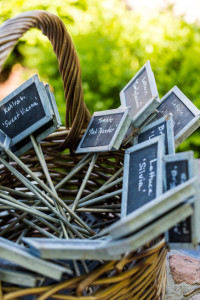Plant Markers for Perennials Will Help Guide Your Fall Trimming
 As we officially enter fall it’s time to think about which perennials will need to be cut back for the winter and which can be left until spring. If you put out plant markers for perennials now, you can feel secure about your cutting even after distinctive leaves and blooms disappear. Some plants enjoy being divided and transplanted during cool weather. Others can continue providing pleasure and usefulness through the winter. Here are some guidelines to help you decide which perennials to cut down, which to leave and which should be divided now.
As we officially enter fall it’s time to think about which perennials will need to be cut back for the winter and which can be left until spring. If you put out plant markers for perennials now, you can feel secure about your cutting even after distinctive leaves and blooms disappear. Some plants enjoy being divided and transplanted during cool weather. Others can continue providing pleasure and usefulness through the winter. Here are some guidelines to help you decide which perennials to cut down, which to leave and which should be divided now.
1. Visual Interest
One reason you might decide to hold off on cutting back your plants is to maintain some visual interest in your yard. Ornamental grasses that truly come into their own during fall can safely be left alone and enjoyed long after winter arrives. The contrast of straw-colored stalks against white snow can be pleasing. Some gardeners enjoy this contrast so much that they don’t cut back ornamental grasses until after the first blooms of spring have come and gone. Clearly labeled plant markers for perennials will let visitors see how your summer plants can be beautiful even in a more bleak landscape.
2. Winter Birds
Many gardeners plant with an eye to the wildlife they hope to attract. Butterflies, bees and hummingbirds are all welcome visitors to the spring and summer garden. But why should you stop thinking about attracting wildlife in fall and winter? Many of your perennials will produce fall seeds to feed hungry birds. The list of seed-producing perennials birds will enjoy includes: Purple Coneflower, Aster, Rudbeckia, Agastache, Astilbe, Erynglum and many more.
3. Evergreens Should be Left Alone
Some perennials (Shasta Daisies, Aster, Bearded Iris, Poppies etc.) boast a rosette of evergreen leaves at ground-level. Go ahead and cut back the stems, but leave the rosette alone in fall. Other evergreens which don’t need fall trimming include: Lavender, Liriope, Phlox, Hellebore, Sempervivium and others. You could trim these after their first blooms appear or avoid trimming altogether. The verdant green is pleasing during seasons of dark and grey.
4. How Much to Cut
If you do decide to cut back a bushy perennial, you don’t necessarily need to cut it right down to the ground. Especially if you plan to divide the plant and root some of it in another spot. Just trim back half or so of the stems. Transplanting in cool fall is perfectly fine since the pre-frost ground will still allow roots to grab hold. Just be sure to use plant markers for perennials you move so that next spring you don’t forget what is where!
Perennials are great garden additions for many reasons. They can provide something interesting and attractive in your landscape long after annuals have disappeared. Feel free to experiment with cutting down, not cutting down, dividing and moving. These hardy plants can normally withstand your gardening learning curve. When it comes to plant markers for perennials you want signage that shows the same kind of hardiness. Check out our top-notch markers at Kincaid Plant Markers and continue reaping the garden benefits nearly all year long.
